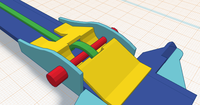 | |
 | |
| Type of site | 3D modeling, Computer Aided Design |
|---|---|
| Owner | Autodesk |
| URL | www |
| Commercial | Yes |
| Registration | Yes |
| Launched | 2011 |
| Written in | WebGL, JavaScript |
Tinkercad is a free-of-charge, online 3D modeling program that runs in a web browser. Since it became available in 2011 it has become a popular platform for creating models for 3D printing as well as an entry-level introduction to constructive solid geometry in schools.
History
Tinkercad was founded by former Google engineer Kai Backman and his cofounder Mikko Mononen, with a goal to make 3D modeling, especially the design of physical items, accessible to the general public, and allow users to publish their designs under a Creative Commons license. In 2011, the tinkercad.com website was launched as a web-based 3D modeling tool for WebGL-enabled browsers, and in 2012 the company moved its headquarters to San Francisco. By 2012, over 100,000 3D designs had been published by users.
In May 2013, Autodesk announced at a Maker Faire that they would acquire Tinkercad.
In March 2017, Autodesk recommended users of the soon-to-be-retired 123D Sculpt migrate to Tinkercad (or Maya LT). In May, Autodesk discontinued its 123D Circuits (Circuits.io) "Electronics Lab". The program's features were merged into Tinkercad.
Concept

Tinkercad uses a simplified constructive solid geometry method of constructing models. A design is made up of primitive shapes that are either "solid" or "hole". Combining solids and holes together, new shapes can be created, which in turn can be assigned the property of solid or hole. In addition to the standard library of primitive shapes, a user can create custom shape generators using a built-in JavaScript editor.
File formats
Shapes can be imported in three formats: STL and OBJ for 3D, and 2-dimensional SVG shapes for extruding into 3D shapes. Tinkercad exports models in STL or OBJ formats, ready for 3D printing.
Tinkercad also includes a feature to export 3D models to Minecraft Java Edition, and also offers the ability to design structures using Lego bricks.
Tinkercad also has the option to test designs in "sim lab" using axle, motor, joint, and slider connectors, and simulates gravity.
Circuits
Tinkercad's Circuits section is a browser-based electronic circuit simulator that supports Arduino Uno microcontrollers, Micro:bit boards, or ATtiny chips. Code can be created using graphical CodeBlocks, pieces of code that can be easily arranged with the mouse, or text-based code. Digi-Key praised Tinkercad in a 2022 article for its intuitive and fast tool capabilities, making it ideal for beginners. The program offers pre-built circuits called "Starters" or circuits that can be built using separate components.
Tinkercad comes with built-in libraries for popular components, including the Adafruit Neopixel, Arduino Servo, and I2C display libraries. However, custom libraries cannot be selected or uploaded. The simulator also supports analog components that are fully simulated.
Despite being an entry-level tool for programming and electronics, Tinkercad offers advanced features such as multi-board simulation and complex analog circuits for experienced users.
See also
References
- Herrman, John. "How to Get Started 3D Modeling and Printing". PopularMechanics.com. Hearst Communication. Archived from the original on 29 January 2015. Retrieved 19 May 2013.
- David Gewirtz (15 May 2019). "Everything you need to know about 3D printing and its impact on your business". ZDnet. Archived from the original on 6 March 2020. Retrieved 17 October 2019.
- ^ Timothy Dahl (13 June 2012). "3-D Design for Idiots: An Interview With Tinkercad Founder Kai Backman". Wired.com. Archived from the original on 18 February 2017. Retrieved 17 October 2019.
- "Tinkercad uses WebGL, a new 3D web standard". Archived from the original on 14 May 2012.
- ^ Kai Backman (31 August 2012). "Tinkercad largest public repository of solid models". Archived from the original on 17 October 2019. Retrieved 17 October 2019.
- Nathan Hurst (18 May 2013). "Autodesk Purchases, Revives 3-D Design App Tinkercad". Wired.com. Archived from the original on 9 June 2019. Retrieved 17 October 2019.
- Gewirtz, David. "Do this right now to save your Autodesk 123D designs from shutdown oblivion". ZDNet. Retrieved 28 October 2020.
- Autodesk Circuits is winding down Archived 19 August 2018 at the Wayback Machine, Autodesk
- Autodesk 123D apps Archived 27 May 2020 at the Wayback Machine, Autodesk
- Electronics Lab is now Tinkercad Circuits Archived 19 August 2018 at the Wayback Machine, Autodesk, May 23, 2017
- Brian Heater (14 August 2013). "Tinkercad lets you export 3D designs into Minecraft". Engadget. Archived from the original on 10 February 2019. Retrieved 17 October 2019.
- Donald Papp (12 September 2017). "Lego prototyping with Tinkercad's brick mode". Archived from the original on 1 November 2019. Retrieved 1 November 2019.
- "Learn how to use Tinkercad". Tinkercad. Archived from the original on 28 July 2022. Retrieved 29 March 2023.
- "Getting Started with Tinkercad Circuits". www.digikey.com. Digi-Key. 4 April 2022. Archived from the original on 3 December 2022. Retrieved 19 May 2023.
External links
| Autodesk products | |||||
|---|---|---|---|---|---|
| Autodesk Media and Entertainment |
| ||||
| Autodesk Engineering, Architecture, & Construction |
| ||||
| Autodesk Product Design & Manufacturing | |||||